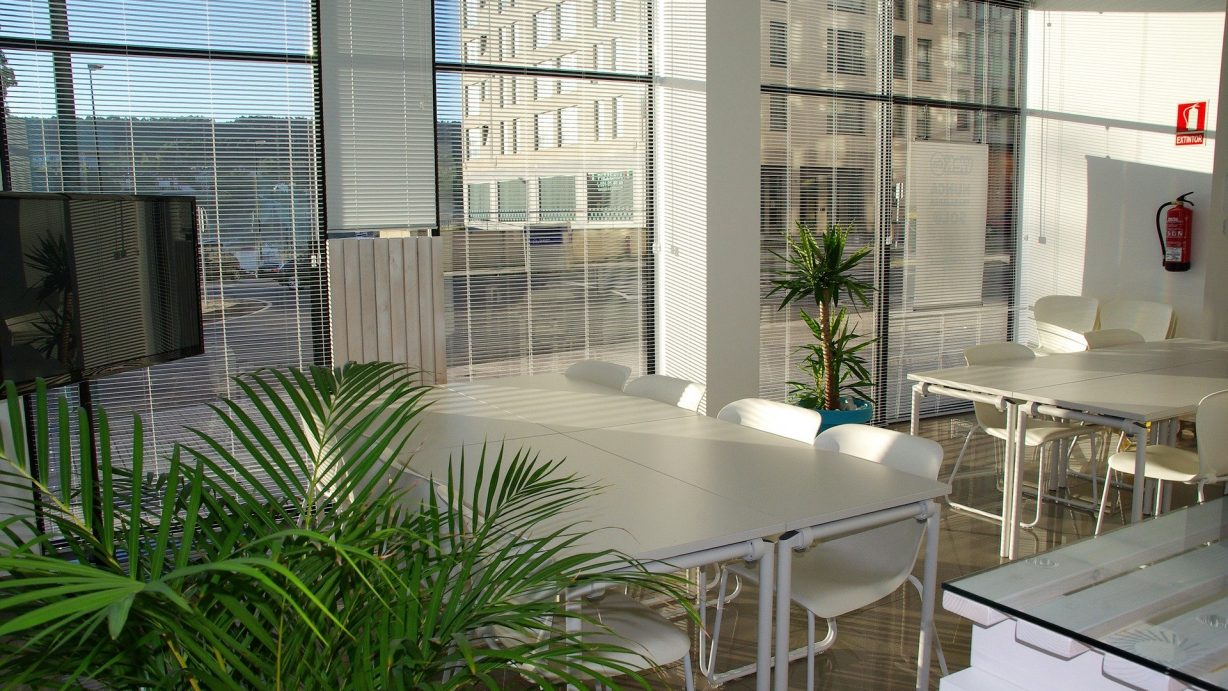After an enforced but largely successful transition to remote working in Spring 2020, few law firms are anticipating a return to the old way of operating. Hybrid arrangements look set to become the norm, with varying degrees of office and home-based working.
From a business perspective, the motivations for formalising hybrid working are varied: maintaining competitiveness in the recruitment market, securing significant savings on-premises costs and creating a flexible working environment that meets workers’ personal preferences. Some of our clients at Lights-On are planning some fairly substantial reductions in floor space, whereas others are reimagining how they will use their premises once people start coming back into the office on a more regular basis.
One client is moving from 100 desks to 20, with the space being repurposed for flexible client meeting rooms, collaboration areas and a business lounge with on-demand catering. Another is envisaging a three-fold reduction in floor space, potentially saving in excess of £2 million in property costs over the next two years.
To be executed successfully, a revised premises strategy needs to focus on a number of connected areas across the business.
Steve Whitwham and Colin Mounsey of Lights-On Consulting set out the five inter-connected workstreams law firms must consider for a resilient and agile technology strategy to support a new way of working, post-pandemic:
- People and culture
- Compliance (including supervision)
- Digitisation of central services
- Tools and training – IT and non-IT
- Property and facilities
1. The people and culture workstream
Every law firm has its own distinct culture; anyone who has worked for a number of firms will testify to this. It might be hard to identify your absolute points of difference in the market but, to employees, the cultural differences are tangible – and play a strong part (or otherwise!) in the success of your firm in recruiting and retaining quality talent.
But how do you retain your culture and ethos if people aren’t seeing each other on a consistent basis?
A ‘people charter’ can help to create and maintain a shared understanding of expected behaviours across the firm.
From a tech perspective, there is a raft of collaboration tools that allow quick communications and messaging, that might be missed without the ‘watercooler moments’.
Many firms are also investing in new intranets that allow for these more social and informal communications to run sideways and upwards, rather than simply top-down from senior management.
We are also seeing firms focus more explicitly on wellbeing, providing opportunities for colleagues to get together remotely for activities such as online yoga or wine tasting, or socially distanced ‘net-walking’.
From a regulatory perspective, there are multiple areas to consider, of which two key areas are employment contracts and health and safety.
Taking health and safety first, a change in work environment to include a home ‘office’ on a longer-term basis necessitates consideration of the physical set-up – desks, chairs and so forth. Will you need to make physical visits to ensure home-work stations are adequate and not a recipe for a slew of bad backs in a year’s time?
Employment contracts may need to be revisited for staff members who will no longer be office-based. Don’t underestimate the work this will create for your HR team – investing in a cloud-based document signature solution could help to mitigate some of this.
2. The compliance (including supervision) workstream
Whilst the last 12 months have proved that most firms can work remotely pretty successfully, legal supervision remains a concern for most firms. There is a consensus that junior fee-earners tend to need more on-site support and resource. How do you create a partner of tomorrow if they haven’t had the opportunity to work closely with, and learn from, senior colleagues?
Your PI insurance will also be influenced by certain levels of supervision. Can this be maintained if your five offices have become 400 offices with people working at home? Insurers have become more demanding, making it essential to engage with your broker early and understand their stance.
If your firm holds a Cyber Essentials accreditation or ISO 27001, you need to give this some real thought to understand the implications of a hybrid working strategy on your certification. The cyber threat position has escalated during the pandemic, with smaller firms being particularly vulnerable. System upgrades are as important as ever but are they still happening? There can be the temptation at the end of a busy day to just ‘shut the lid’ on the laptop, but a fleet of laptops that are not switched off at the end of the day leave your firm far more open to a cyber-attack as important updates are often part of the shutdown or start-up process.
A reminder about end-of-day log-off and shutdown is highly recommended.
Another hot topic in this area is home printing and how your people maintain compliance with confidentiality and destruction of data requirements. Some firms have locked down printing to then find that staff are emailing documents to their personal email address so they can print them at home. There is generally no malintent here, just a perceived need for a physical document. There are some sophisticated data exfiltration solutions that can help you to understand the scale of this type of problem – and put in place relevant solutions to remedy it.
Finally, firms will need to revisit a number of their people policies to take account of homeworking. Computer usage and confidentiality should be top of your list for a re-write.
3. The digitisation of central services workstream
For law firms with a more organic or individualised culture, imposing central controls can feel like an unwelcome step.
However, at Lights-On, we are seeing firms enjoy great benefits from centralising and digitising back-office functions, creating clear processes for functions such as billing, distribution of post, and digital dictation. There are also cost savings to be made on printers and printing: we have recently helped one law firm to cut their managed print costs by 25 percent, representing a £100,000 saving simply by handling print in a more considered manner.
Huge economies of scale can be achieved through successful centralisation, but a ‘hearts and minds’ approach is essential as people can be wedded to their processes and need careful and considered persuasion to adopt new systems.
4. The tools and training – IT and non-IT workstream
Working from home is sorted. We know how to do this – but are our homeworking practices compliant and are they sustainable as our firms grow?
If people are working from home strategically and for the long term, what do they need to be productive and to maintain compliance? This may require technology and non-IT solutions such as a decent office chair, standing desks for those with bad backs or support with securing a better broadband package.
If you ask your team what they miss about the office, they will usually talk about their colleagues, the informal conversations and the chances for collaboration. There is a lot that technology can do to enable knowledge share and collaboration in a remote environment, and the good news is that there are lots of tools available to help us with this – including within the Office 365 suite.
One area that firms are wrestling with is how to run effective meetings when some people are in the office, some at home, and perhaps some on the move or at the train station. Technology is the glue that can hold all this together and ensure fair and equal input, from wherever people are accessing the meeting.
If your law firm is considering reducing floor space, what tools do you need to get the best use out of your office environment?
Room-booking and desk-booking systems can be helpful and we have seen a number in action with various pros and cons that need to be considered. Other useful tools include the now widely available e-signing and deal room products that help to reduce paperwork, improve the client experience and enable work to progress when you can’t meet face to face.
Above all though, training is absolutely key.
When we all worked in the office, a lot of training and knowledge share used to happen through virtue of proximity – a shout over to a colleague with a ‘how should I do X’ type request. With remote working, end-user training and how to deliver it should be top of the agenda for IT leaders, from induction and onboarding through to the continued development of experienced staff members.
How will the traditional IT Service Desk support people in lots of different locations and where key elements of the solution – such as the home user’s broadband – are not owned by the firm? Successful firms are taking a different approach to this, with remote support and problem-solving on a range of areas, including helping users to improve their broadband provision.
5. The property and facilities workstream
The fifth workstream to be considered in a move to a hybrid / agile environment is, of course, your premises. This goes beyond the property and the fit-out and should encompass how you expect the office space to be used; why people should come in – and, most importantly, what you expect them to do when they are in the office.
On a more prosaic note, whilst we are still in the grip of COVID, your property strategy should also take in your plans for a forensic end-of-day clean down and footfall – for example, how will you manage routes to the printer, the kitchen and so forth to maintain COVID security.
COVID has created an opportunity for law firms to make significant changes in the way they work, for the better of both clients and employees. But change can’t be allowed to happen accidentally. Each of the five workstreams noted above are interconnected and need to be collectively addressed in a clear and considered way to ensure long-term success.
From managing the ticking timebomb of sensitive information being stored at home through to maintaining your valuable culture, law firm leaders are having to be both strategic and tactical in their approaches to post-pandemic working.
For advice on any of the topics raised in this article, including thoughts on what to include in a post-pandemic people charter, please do get in touch.
This article was first published in Alternative Insights.

